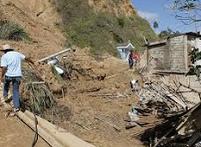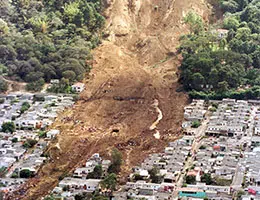 The term landslide comes from the Latin word delābi , which can be translated as “to slide.” The concept, which can also be mentioned as landslide , refers to the collapse or fall of land as a result of the action of a current of water .
The term landslide comes from the Latin word delābi , which can be translated as “to slide.” The concept, which can also be mentioned as landslide , refers to the collapse or fall of land as a result of the action of a current of water .
The landslide, therefore, is linked to the erosion generated by water on a bank and the effect of the force of gravity . It can also be a landslide that is caused by rain when the water causes a layer of soil to separate from the bedrock.
Other names by which the landslide is known are landslide and landslide , and it is a disaster that is linked to avalanches ; However, instead of a snow slide, the landslide carries rocks, dirt, trees and ruined buildings, among other objects.
Sometimes the landslide is almost imperceptible, since the land only moves a few centimeters. In other cases, however, the landslide can be very fast, with movements of more than 30 kilometers per hour. When a landslide of many tons of earth occurs very quickly, it is possible that a tragedy will occur since entire towns may be buried.
The reasons why a landslide can occur are several, and cover both natural and human-caused issues; For example, it can occur as a result of instability around the area , due to earthquakes or the eruption of a volcano, but also as a result of an explosion in the context of a construction site.
Specifically, landslides occur when water enters between different layers of soil. These layers are linked by friction , which exerts resistance to slipping . Water, by eliminating this force, therefore causes the land to slide. That is why intense rainfall, the growth of groundwater, the melting of snow and the erosion produced by a current can lead to a landslide.
 The landslide is, in short, a landslide: a mass of land (which is considered unstable ) moves over another (the so-called stable ) through a thin surface. For the landslide to occur, the tangential tension of the strips of land must reach its maximum value at each of its points. It is known as tangential or shear stress, which acts tangent to a given plane.
The landslide is, in short, a landslide: a mass of land (which is considered unstable ) moves over another (the so-called stable ) through a thin surface. For the landslide to occur, the tangential tension of the strips of land must reach its maximum value at each of its points. It is known as tangential or shear stress, which acts tangent to a given plane.
Some landslides consist of mudslides; These flows occur especially in areas with frequent rainfall and usually cover considerable surfaces. When a clay soil comes into contact with water, it acts in a similar way to when it reaches the liquid limit (the percentage of water that dry soil contains and that delimits the transition between its liquid and plastic states; the smallest amount of moisture for a soil flows by vibration) and its movement is slower than that of a landslide.
Mudslides take place on small slopes, but the volume is usually considerable. Its impact on the area of influence depends on the stratigraphic characteristics of the site in which the phenomenon takes place (the arrangement of its sedimentary rocks), something that also affects the thickness of the landslide.
There are, in short, morphological and geological causes that cause landslides, while human activity can also affect them. Although they cannot be avoided since they respond to physical forces, their damage can be prevented or minimized through engineering works. Landslides related to the rainy season are very regular in certain parts of the world, such as the state of California, in North America.
